ILO公约清单
- 格式:pdf
- 大小:48.50 KB
- 文档页数:2

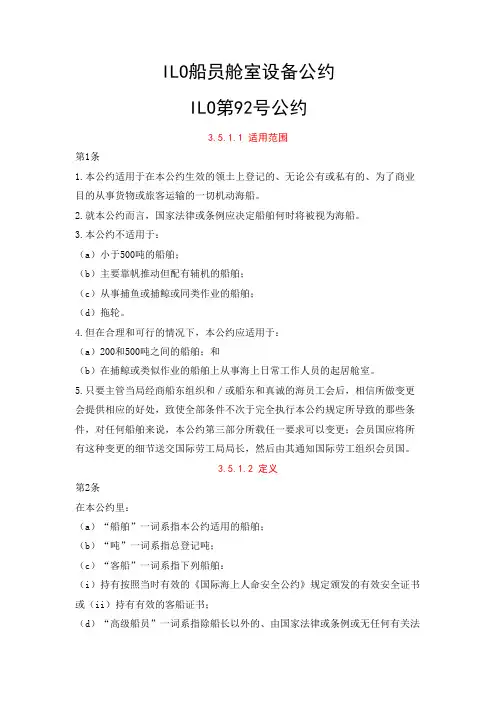
ILO船员舱室设备公约ILO第92号公约3.5.1.1 适用范围第1条1.本公约适用于在本公约生效的领土上登记的、无论公有或私有的、为了商业目的从事货物或旅客运输的一切机动海船。
2.就本公约而言,国家法律或条例应决定船舶何时将被视为海船。
3.本公约不适用于:(a)小于500吨的船舶;(b)主要靠帆推动但配有辅机的船舶;(c)从事捕鱼或捕鲸或同类作业的船舶;(d)拖轮。
4.但在合理和可行的情况下,本公约应适用于:(a)200和500吨之间的船舶;和(b)在捕鲸或类似作业的船舶上从事海上日常工作人员的起居舱室。
5.只要主管当局经商船东组织和/或船东和真诚的海员工会后,相信所做变更会提供相应的好处,致使全部条件不次于完全执行本公约规定所导致的那些条件,对任何船舶来说,本公约第三部分所载任一要求可以变更;会员国应将所有这种变更的细节送交国际劳工局局长,然后由其通知国际劳工组织会员国。
3.5.1.2 定义第2条在本公约里:(a)“船舶”一词系指本公约适用的船舶;(b)“吨”一词系指总登记吨;(c)“客船”一词系指下列船舶:(i)持有按照当时有效的《国际海上人命安全公约》规定颁发的有效安全证书或(ii)持有有效的客船证书;(d)“高级船员”一词系指除船长以外的、由国家法律或条例或无任何有关法律或条例时,由集体协议或惯例定为高级船员的人员;(e)“普通船员”一词系指非高级船员的船员;(f)“准高级船员”一词系指以监督身份或特殊任务身份工作的根据国家法律或条例定为准高级船员的普通船员;在无任何有关法律或条例时,由集体协议或惯例定为准高级船员的普通船员;(g)“船员起居舱室”一词系指供船员使用的卧室、餐室、卫生间、医务室和娱乐室;(h)“规定的”一词意指由国家法律或条例或由主管当局规定的;(i)“认可的”一词意指由主管当局认可的;(j)“重新登记的”一词系指在登记领土和船舶所有权同时变更的情况下重新登记的。
3.5.1.3 船员起居舱室的计划与管理第4条1.在船舶建造动工前,以规定的比例展示船员起居舱室的位置和一般布置的船舶平面图应送请主管当局认可。

国际劳工组织公约国际劳工组织(International Labour Organization,简称ILO)是联合国的专门机构,成立于1919年。
作为全球推动和保护劳工权益的重要组织,ILO通过通过制定和推动执行劳工标准、促进就业和社会保障、改善工作条件以及加强对劳资关系的管理等方面的工作,致力于实现全球劳工的公正与尊严。
为了确保国际劳工组织成员国之间的合作和遵守劳工标准,ILO制定了一系列公约,以下将重点介绍其中几个具有重要影响的公约。
一、《工时公约》《工时公约》是由国际劳工组织于1919年制定的第一项公约,也是ILO建立的第一个劳工标准。
该公约规定了每日和每周工作时间的上限,以及为超时工作支付加班费的情况。
它的主要目的是保护劳动者的身体和心理健康,确保合理的工作时间和休息时间。
二、《无工时限制公约》《无工时限制公约》是于1935年通过的,旨在进一步保护劳动者的工作时间和休息时间。
该公约鼓励国家确立正常工作时数,并提倡为超过正常工作时间的劳动提供适当的补偿。
三、《强迫劳动公约》《强迫劳动公约》于1930年通过,旨在消除一切形式的强迫劳动。
它规定了强迫劳动的定义,并要求各国采取有效措施,制定国内法律以防止和惩治强迫劳动的发生。
四、《最低工资公约》《最低工资公约》是1936年通过的,目的是确保全球劳动力获得足够的报酬以维持其基本生活需要。
该公约要求各国制定并实施最低工资政策,并确保该政策覆盖所有行业和工种。
五、《集体谈判公约》《集体谈判公约》于1949年通过,旨在保护劳动者的集体谈判权利,并推动劳资双方的和谐合作。
该公约鼓励雇主与工会就工资、工时、工作条件等进行谈判,并提供行业协商机构的设立。
六、《歧视就业和职业机会公约》《歧视就业和职业机会公约》是1958年通过,该公约要求各国采取措施,消除就业和职业机会方面的歧视。
公约重点关注对待男女劳动者的平等原则,以及对待各个群体之间的平等原则。
七、《童工公约》《童工公约》于1973年通过,旨在防止和消除童工问题。
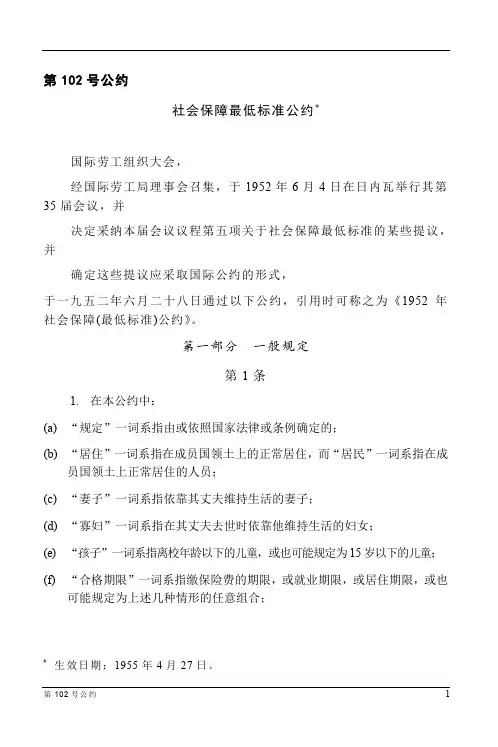

国际劳工公约数目
国际劳工公约是指由国际劳工组织(ILO)制定的国际劳工标准,旨在保护和促进全球工人的权益和福利。
下面是关于国际劳工公约数目的一些重要信息:
1. 目前,国际劳工组织已经草拟了189项公约,其中包括8项核心公约。
- 核心公约是指针对最为紧急和重要的劳工问题的规范性文件。
这些公约的颁布旨在使劳工权益得到保护和促进,而且较为具有约束力。
- 这8项核心公约分别包括:禁止使用童工(最低工作年龄公约)、消除强迫劳动(强制劳工公约)、保证受雇者结社权利和采取集体谈判(结社权公约)、消除歧视限制劳动就业和职业的公约,以及其他几项公约。
2. 除了核心公约,ILO还颁布了其他的公约,包括但不限于:
- 国家就业政策公约
- 农民工公约
- 废除强迫劳动公约
- 国际保护工人报酬公约
- 工人住宿条件公约
- 卫生医疗服务公约
- 职业安全健康公约
- 国际劳工移民保护公约
- 劳动标准概述公约
3. 这些公约在全球范围内广泛应用,其内容涉及许多劳动问题,包括劳动法律、安全卫生、人权和工资收入,旨在确保所有劳工能够在公平和健康的环境下工作。
4. 然而,虽然ILO颁布了这些公约,但不是所有国家都实施了它们。
因此,众多非政府组织和人权组织都在致力于推动更多国家遵守并落实这些公约。
综上所述,国际劳工公约的数目是非常庞大的,反映了全球劳动力市场上各种各样的问题。
虽然其中一些公约得到了广泛遵守,但是还有许多国家应该将这些准则应用到实际情况中,以确保所有劳工都能够得到应有的保护和待遇。
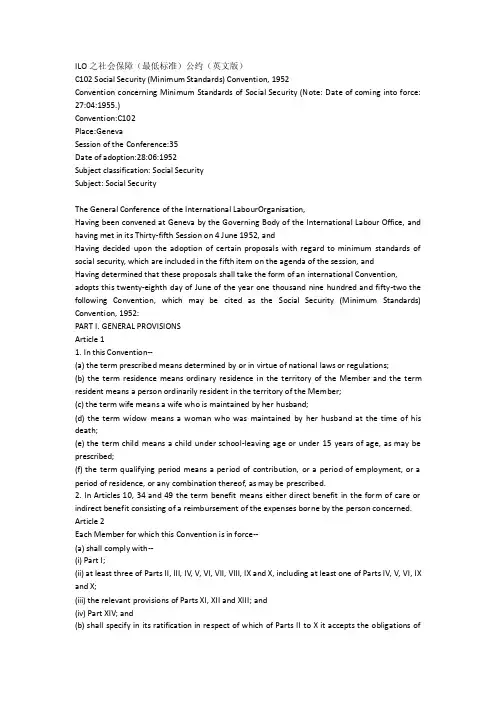
ILO之社会保障(最低标准)公约(英文版)C102 Social Security (Minimum Standards) Convention, 1952Convention concerning Minimum Standards of Social Security (Note: Date of coming into force: 27:04:1955.)Convention:C102Place:GenevaSession of the Conference:35Date of adoption:28:06:1952Subject classification: Social SecuritySubject: Social SecurityThe General Conference of the International LabourOrganisation,Having been convened at Geneva by the Governing Body of the International Labour Office, and having met in its Thirty-fifth Session on 4 June 1952, andHaving decided upon the adoption of certain proposals with regard to minimum standards of social security, which are included in the fifth item on the agenda of the session, andHaving determined that these proposals shall take the form of an international Convention, adopts this twenty-eighth day of June of the year one thousand nine hundred and fifty-two the following Convention, which may be cited as the Social Security (Minimum Standards) Convention, 1952:PART I. GENERAL PROVISIONSArticle 11. In this Convention--(a) the term prescribed means determined by or in virtue of national laws or regulations;(b) the term residence means ordinary residence in the territory of the Member and the term resident means a person ordinarily resident in the territory of the Member;(c) the term wife means a wife who is maintained by her husband;(d) the term widow means a woman who was maintained by her husband at the time of his death;(e) the term child means a child under school-leaving age or under 15 years of age, as may be prescribed;(f) the term qualifying period means a period of contribution, or a period of employment, or a period of residence, or any combination thereof, as may be prescribed.2. In Articles 10, 34 and 49 the term benefit means either direct benefit in the form of care or indirect benefit consisting of a reimbursement of the expenses borne by the person concerned. Article 2Each Member for which this Convention is in force--(a) shall comply with--(i) Part I;(ii) at least three of Parts II, III, IV, V, VI, VII, VIII, IX and X, including at least one of Parts IV, V, VI, IX and X;(iii) the relevant provisions of Parts XI, XII and XIII; and(iv) Part XIV; and(b) shall specify in its ratification in respect of which of Parts II to X it accepts the obligations ofthe Convention.Article 31. A Member whose economy and medical facilities are insufficiently developed may, if and for so long as the competent authority considers necessary, avail itself, by a declaration appended to its ratification, of the temporary exceptions provided for in the following Articles: 9 (d) ; 12 (2); 15(d); 18 (2); 21 (c); 27 (d) ; 33 (b); 34 (3); 41 (d); 48 (c); 55 (d); and 61 (d).2. Each Member which has made a declaration under paragraph 1 of this Article shall include in the annual report upon the application of this Convention submitted under Article 22 of the Constitution of the International LabourOrganisation a statement, in respect of each exception of which it avails itself--(a) that its reason for doing so subsists; or(b) that it renounces its right to avail itself of the exception in question as from a stated date. Article 41. Each Member which has ratified this Convention may subsequently notify the Director-General of the International Labour Office that it accepts the obligations of the Convention in respect of one or more of Parts II to X not already specified in its ratification.2. The undertakings referred to in paragraph 1 of this Article shall be deemed to be an integral part of the ratification and to have the force of ratification as from the date of notification. Article 5Where, for the purpose of compliance with any of the Parts II to X of this Convention which are to be covered by its ratification, a Member is required to protect prescribed classes of persons constituting not less than a specified percentage of employees or residents, the Member shall satisfy itself, before undertaking to comply with any such Part, that the relevant percentage is attained.Article 6For the purpose of compliance with Parts II, III, IV, V, VIII (in so far as it relates to medical care), IX or X of this Convention, a Member may take account of protection effected by means of insurance which, although not made compulsory by national laws or regulations for the persons to be protected--(a) is supervised by the public authorities or administered, in accordance with prescribed standards, by joint operation of employers and workers;(b) covers a substantial part of the persons whose earnings do not exceed those of the skilled manual male employee; and(c) complies, in conjunction with other forms of protection, where appropriate, with the relevant provisions of the Convention.PART II. MEDICAL CAREArticle 7Each Member for which this Part of this Convention is in force shall secure to the persons protected the provision of benefit in respect of a condition requiring medical care of a preventive or curative nature in accordance with the following Articles of this Part.Article 8The contingencies covered shall include any morbid condition, whatever its cause, and pregnancy and confinement and their consequences.Article 9The persons protected shall comprise--(a) prescribed classes of employees, constituting not less than 50 per cent. of all employees, and also their wives and children; or(b) prescribed classes of economically active population, constituting not less than 20 per cent. of all residents, and also their wives and children; or(c) prescribed classes of residents, constituting not less than 50 per cent. of all residents; or(d) where a declaration made in virtue of Article 3 is in force, prescribed classes of employees constituting not less than 50 per cent. of all employees in industrial workplaces employing 20 persons or more, and also their wives and children.Article 101. The benefit shall include at least--(a) in case of a morbid condition--(i) general practitioner care, including domiciliary visiting;(ii) specialist care at hospitals for in-patients and out-patients, and such specialist care as may be available outside hospitals;(iii) the essential pharmaceutical supplies as prescribed by medical or other qualified practitioners; and(iv) hospitalisation where necessary; and(b) in case of pregnancy and confinement and their consequences--(i) pre-natal, confinement and post-natal care either by medical practitioners or by qualified midwives; and(ii) hospitalisation where necessary.2. The beneficiary or his breadwinner may be required to share in the cost of the medical care the beneficiary receives in respect of a morbid condition; the rules concerning such cost-sharing shall be so designed as to avoid hardship.3. The benefit provided in accordance with this Article shall be afforded with a view to maintaining, restoring or improving the health of the person protected and his ability to work and to attend to his personal needs.4. The institutions or Government departments administering the benefit shall, by such means as may be deemed appropriate, encourage the persons protected to avail themselves of the general health services placed at their disposal by the public authorities or by other bodies recognised by the public authorities.Article 11The benefit specified in Article 10 shall, in a contingency covered, be secured at least to a person protected who has completed, or whose breadwinner has completed, such qualifying period as may be considered necessary to preclude abuse.Article 121. The benefit specified in Article 10 shall be granted throughout the contingency covered, except that, in case of a morbid condition, its duration may be limited to 26 weeks in each case, but benefit shall not be suspended while a sickness benefit continues to be paid, and provision shall be made to enable the limit to be extended for prescribed diseases recognised as entailing prolonged care.2. Where a declaration made in virtue of Article 3 is in force, the duration of the benefit may be limited to 13 weeks in each case.PART III. SICKNESS BENEFITArticle 13Each Member for which this Part of this Convention is in force shall secure to the persons protected the provision of sickness benefit in accordance with the following Articles of this Part. Article 14The contingency covered shall include incapacity for work resulting from a morbid condition and involving suspension of earnings, as defined by national laws or regulations.Article 15The persons protected shall comprise--(a) prescribed classes of employees, constituting not less than 50 per cent. of all employees; or(b) prescribed classes of the economically active population, constituting not less than 20 per cent. of all residents; or(c) all residents whose means during the contingency do not exceed limits prescribed in such a manner as to comply with the requirements of Article 67; or(d) where a declaration made in virtue of Article 3 is in force, prescribed classes of employees, constituting not less than 50 per cent. of all employees in industrial workplaces employing 20 persons or more.Article 161. Where classes of employees or classes of the economically active population are protected, the benefit shall be a periodical payment calculated in such a manner as to comply either with the requirements of Article 65 or with the requirements of Article 66.2. Where all residents whose means during the contingency do not exceed prescribed limits are protected, the benefit shall be a periodical payment calculated in such a manner as to comply with the requirements of Article 67.Article 17The benefit specified in Article 16 shall, in a contingency covered, be secured at least to a person protected who has completed such qualifying period as may be considered necessary to preclude abuse.Article 181. The benefit specified in Article 16 shall be granted throughout the contingency, except that the benefit may be limited to 26 weeks in each case of sickness, in which event it need not be paid for the first three days of suspension of earnings.2. Where a declaration made in virtue of Article 3 is in force, the duration of the benefit may be limited--(a) to such period that the total number of days for which the sickness benefit is granted in any year is not less than ten times the average number of persons protected in that year; or(b) to 13 weeks in each case of sickness, in which event it need not be paid for the first three days of suspension of earnings.PART IV. UNEMPLOYMENT BENEFITArticle 19Each Member for which this Part of this Convention is in force shall secure to the persons protected the provision of unemployment benefit in accordance with the following Articles of this Part.Article 20The contingency covered shall include suspension of earnings, as defined by national laws or regulations, due to inability to obtain suitable employment in the case of a person protected who is capable of, and available for, work.Article 21The persons protected shall comprise--(a) prescribed classes of employees, constituting not less than 50 per cent. of all employees; or(b) all residents whose means during the contingency do not exceed limits prescribed in such a manner as to comply with the requirements of Article 67; or(c) where a declaration made in virtue of Article 3 is in force, prescribed classes of employees, constituting not less than 50 per cent. of all employees in industrial workplaces employing 20 persons or more.Article 221. Where classes of employees are protected, the benefit shall be a periodical payment calculated in such manner as to comply either with the requirements of Article 65 or with the requirements of Article 66.2. Where all residents whose means during the contingency do not exceed prescribed limits are protected, the benefit shall be a periodical payment calculated in such a manner as to comply with the requirements of Article 67.Article 23The benefit specified in Article 22 shall, in a contingency covered, be secured at least to a person protected who has completed such qualifying period as may be considered necessary to preclude abuse.Article 241. The benefit specified in Article 22 shall be granted throughout the contingency, except that its duration may be limited--(a) where classes of employees are protected, to 13 weeks within a period of 12 months, or(b) where all residents whose means during the contingency do not exceed prescribed limits are protected, to 26 weeks within a period of 12 months.2. Where national laws or regulations provide that the duration of the benefit shall vary with the length of the contribution period and/or the benefit previously received within a prescribed period, the provisions of subparagraph (a) of paragraph 1 shall be deemed to be fulfilled if the average duration of benefit is at least 13 weeks within a period of 12 months.3. The benefit need not be paid for a waiting period of the first seven days in each case of suspension of earnings, counting days of unemployment before and after temporary employment lasting not more than a prescribed period as part of the same case of suspension of earnings.4. In the case of seasonal workers the duration of the benefit and the waiting period may be adapted to their conditions of employment.PART V. OLD-AGE BENEFITArticle 25Each Member for which this Part of this Convention is in force shall secure to the persons protected the provision of old-age benefit in accordance with the following Articles of this Part.。

28项国际劳工公约国际劳工公约是国际劳工组织(ILO)制定的具有普遍适用性的国际劳工标准,旨在保护劳工权益、促进劳工福祉、确保公平就业和创造良好的工作环境。
其中,最为重要的是《国际劳工公约》的28项公约,涵盖了各个方面的劳工权益和工作条件,对于保障全球劳工的权益起到了重要的作用。
首先,我们来看看《国际劳工公约》中的一些重要公约,比如第1号公约是关于工作时间的公约,规定了工人每周工作的最大小时数以及工作和休息的时间安排。
第2号公约是关于工资的公约,规定了工人应当获得公平和合理的工资,保障他们的经济权益。
第5号公约是关于工会组织和谈判的公约,规定了工人有权组织工会并进行集体谈判,保障他们的集体权益。
另外,还有一些公约涉及到了特定的工作领域,比如第87号公约是关于自由组织和保护权利的公约,规定了工人有权自由组织工会,保护他们的工会权利。
第98号公约是关于集体谈判的公约,规定了工人有权进行集体谈判,协商工资和工作条件。
第155号公约是关于职业安全和健康的公约,规定了雇主有责任保障工人的工作安全和健康。
除了以上几个公约,国际劳工公约还涵盖了工妇、童工、强迫劳工等方面的问题,对于保护弱势群体的劳工权益也有着重要的作用。
这些公约的制定和执行,不仅促进了国际劳工的权益保护,也有助于建立公平的劳工关系,推动了全球劳工条件的改善和工作环境的提升。
总的来说,国际劳工公约的28项公约涵盖了各个方面的劳工权益和工作条件,是国际劳工组织保护劳工权益的重要工具。
各国应当认真遵守这些公约的规定,保障劳工的权益,创造公平和谐的工作环境,促进经济和社会的可持续发展。
希望各国能够共同努力,落实国际劳工公约的规定,为劳工的权益和福祉做出更多的努力和贡献。
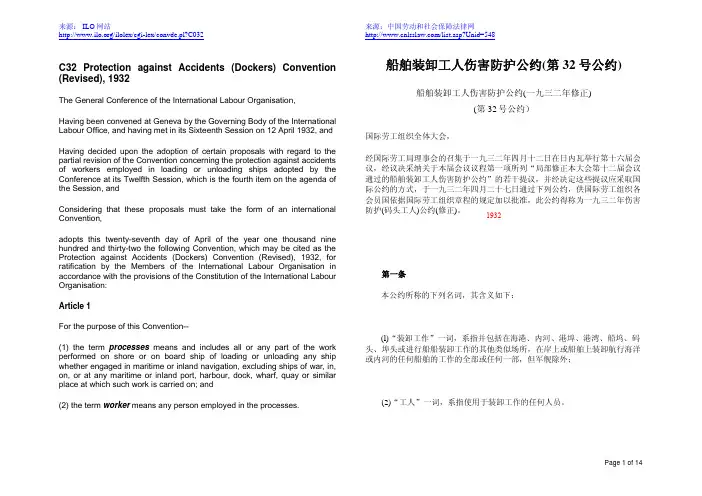

ILO其重设备的公约第152号1979年职业安全与健康(码头工作)公约国际劳工组织全体大会,经国际劳工局理事会召集于1979年6月6日在日内瓦举行第65届会议,注意到有关的现有国际劳工公约和建议书各条款,尤其是《1929年标明重量(船运包装物)公约》、《1963年机器防护公约》和《1977年工作环境(空气污染、噪音和振动)公约》各条款;经议决采纳本届大会议程第4项所列关于修正《1932年伤害防护(码头工人)公约(修正本)》(第32号)的若干提议,考虑到这些提议应采取国际公约的方式,于1979年6月25日通过下述公约,此公约得称为《1979年职业安全与健康(码头工作)公约》。
第一部分范围和定义第1条就本公约而言,“码头工作”一词系指装卸任何船舶的所有和部分工作以及任何相关的工作;这种工作的定义应由国家法律或惯例加以确定。
确定和修正该定义时应征求有关雇主组织和工人组织的意见。
否则这些组织应参加制定。
第2条1、关于交通不规则并仅限于小船通行的任何地方的码头工作以及与渔船有关的或特定种类的码头工作,会员国可以准予免除或允许排除本公约各条款的结束,假若:(a)保持安全的工作条件,和(b)主管当局在与有关雇主和工人组织协商后,确信这种免除或排除在所有情况下是合理的。
2、本公约第三部分的特殊要求可以变更,如果主管当局在与有关雇主和工人组织协商后,确信这些变更可产生相应的益处和给予的全面保护不次于充分实施本公约各条款所产生的保护。
3、在按照国际劳工组织章程第22条提交的实施本公约的报告里应列明根据本条第1款所准许的任何免除或排除和根据本条第2款所做的任何有效的变更及关理由。
第3条就本公约而言:(a)“工人”一词系指从事码头工作的任何人员;(b)“主管人”一词系指具有履行某种职责所需要的知识和经验并可被主管当局接受的人员;(c)“负责人”一词系指雇主、船长或有关装置所有人(视情况而定)任命负责履行某种职责并具有正当履行这些职责的足够知识、经验和必要权威的人员;(d)“受权人”一词系指雇主、船长或负责人授权的承担某种专门任务或多种任务并具有必要的技术知识和经验的人员;(e)“起重设备”一词系指包括岸上动力坡道在内的所有固定或移动式货物装卸设备,供岸上或船上吊挂、升降货物或当货物被吊挂或支撑时将其从一处移到另一处使用;(f)“可拆卸式装置”一词系指可将货物系在起重设备上但又不作为该设备或货物组成部分的任何装置;(g)“入口”一词包括出口;(h)“船舶”一词包括任何种类的船舶、驳船、港内驳船或气垫船,但军舰除外。
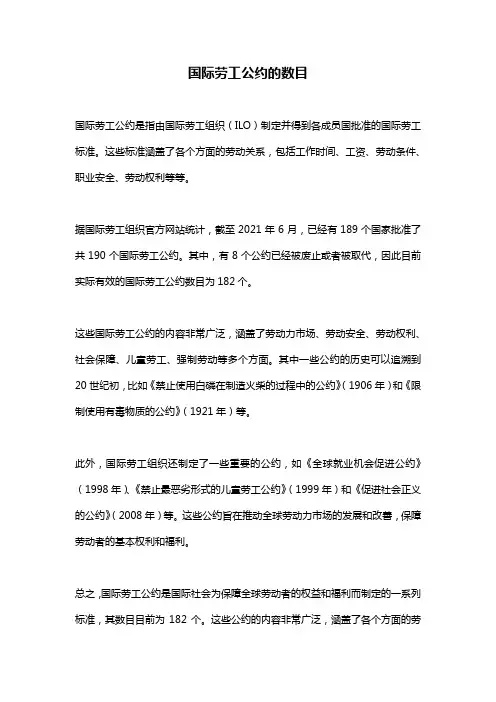
国际劳工公约的数目
国际劳工公约是指由国际劳工组织(ILO)制定并得到各成员国批准的国际劳工标准。
这些标准涵盖了各个方面的劳动关系,包括工作时间、工资、劳动条件、职业安全、劳动权利等等。
据国际劳工组织官方网站统计,截至2021年6月,已经有189个国家批准了共190个国际劳工公约。
其中,有8个公约已经被废止或者被取代,因此目前实际有效的国际劳工公约数目为182个。
这些国际劳工公约的内容非常广泛,涵盖了劳动力市场、劳动安全、劳动权利、社会保障、儿童劳工、强制劳动等多个方面。
其中一些公约的历史可以追溯到20世纪初,比如《禁止使用白磷在制造火柴的过程中的公约》(1906年)和《限制使用有毒物质的公约》(1921年)等。
此外,国际劳工组织还制定了一些重要的公约,如《全球就业机会促进公约》(1998年)、《禁止最恶劣形式的儿童劳工公约》(1999年)和《促进社会正义的公约》(2008年)等。
这些公约旨在推动全球劳动力市场的发展和改善,保障劳动者的基本权利和福利。
总之,国际劳工公约是国际社会为保障全球劳动者的权益和福利而制定的一系列标准,其数目目前为182个。
这些公约的内容非常广泛,涵盖了各个方面的劳
动关系,对于推动全球劳动力市场的发展和改善具有重要的意义。
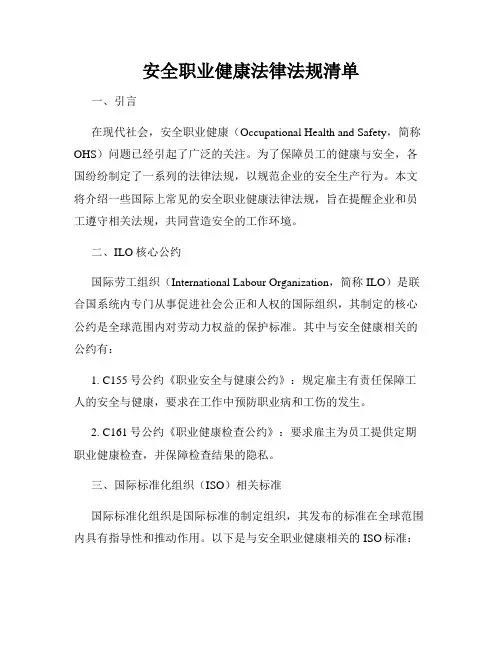
安全职业健康法律法规清单一、引言在现代社会,安全职业健康(Occupational Health and Safety,简称OHS)问题已经引起了广泛的关注。
为了保障员工的健康与安全,各国纷纷制定了一系列的法律法规,以规范企业的安全生产行为。
本文将介绍一些国际上常见的安全职业健康法律法规,旨在提醒企业和员工遵守相关法规,共同营造安全的工作环境。
二、ILO核心公约国际劳工组织(International Labour Organization,简称ILO)是联合国系统内专门从事促进社会公正和人权的国际组织,其制定的核心公约是全球范围内对劳动力权益的保护标准。
其中与安全健康相关的公约有:1. C155号公约《职业安全与健康公约》:规定雇主有责任保障工人的安全与健康,要求在工作中预防职业病和工伤的发生。
2. C161号公约《职业健康检查公约》:要求雇主为员工提供定期职业健康检查,并保障检查结果的隐私。
三、国际标准化组织(ISO)相关标准国际标准化组织是国际标准的制定组织,其发布的标准在全球范围内具有指导性和推动作用。
以下是与安全职业健康相关的ISO标准:1. ISO 45001《职业健康与安全管理体系要求》:是全球通用的职业健康与安全管理体系标准,旨在帮助组织建立起科学有效的职业健康与安全管理体系。
2. ISO 31000《风险管理原则与指南》:为组织提供风险管理的框架,鼓励组织制定相关政策和程序,保护员工的安全与健康。
四、中国相关法律法规在中国,政府出台了一系列的法律法规来保障员工的职业安全与健康。
以下是中国相关的法律法规:1. 《中华人民共和国安全生产法》:规定了各类企业必须遵循的生产安全要求,明确了雇主的安全生产责任和员工的安全生产义务。
2. 《职业病防治法》:规定了职业病的预防、控制和治疗等方面的要求,要求雇主为员工提供安全的劳动环境,防范职业病的发生。
3. 《职业病诊断标准》和《职业病鉴定标准》:规定了职业病的诊断和鉴定标准,为职业病患者的权益保护提供科学依据。
与ILO147号公约相关的公约ILO147号公约的附录中,涉及相关的公约有15个,内容包括船员的最低年龄、船员患病及受伤的医疗保险、船员食品、起居舱室、遣返等有关福利待遇和权利保护等方面的内容。
1.ILO147—船员在船上起居舱室公约该公约的基本要求包括:1)卧室和起居处所A.卧室净高不应小于190cm;B.铺位最小尺寸应为190cm X 68cm,且每个铺位应装配弹性床垫或弹簧垫子或由认可的材料做的垫子,但不得使用稻草或其他易聚藏害虫的物质;C.应提供充足的排水设施、足够的照明;D.取暖器应放置在适当位置,必要时加护罩。
2)卫生设备和洗衣间A.卫生设备的最小数目为每8 个人1个浴缸或淋浴、1个厕所;每6个人1个洗脸盆;B.500总吨及以上船舶应设有够船员使用的洗衣设备。
3)医务室A.在载有15名或以上船员和航程超过3天的任何船舶里,应设单独的医务室;B.医务室的位置应易于出入,便于病人治疗;C.医务室内应提供专供病人使用的厕所;D.医务室不得用做医疗以外的目的;E.每艘不配备医生的船舶应载有一个经认可的带有易懂说明书的医药箱。
2.ILO134号公约—防止海员工伤事故公约该公约于1973年2月17生效,公约要求各海运主管当局应制定防止工伤事故、保护健康的规定。
内容应包括:一般和基本规定、船舶结构特征、机器、甲板上面和下面的特别安全措施、装卸装备、防火和灭火、锚及锚链和绳索、危险品和压载物、海员护身设备等。
公约还要求应在船员中指定一个或几个合适人员或一个委员会,在船长指挥下负责防止事故的工作。
3.ILO22号公约—海员协议条款公约该公约于1928年4月4日生效,有关内容有1)海员协议条款的签订:A.由船舶所有人或其代表与海员双方签订,签订前应让海员审查条款的内容;B.海员应依照国家法律规定签订协议;C.协议中不得载有违背国家法律的内容;D.协议签字后呈送主管机关,应视为协议已经履行;E.船舶所有人与海员的利益应受国家法律的保护。
国际劳工组织“职业安全和卫生及工作环境公约”(第155号公约)国际劳工组织大会,经国际劳工组织大会,经国际劳工局理事会召集,于一九八一年六月三日在日内瓦举行其第六十七届会议并经决定采纳本届会议议程第六项关于安全和卫生及工作环境的某些提议,并经确定这些提议应采取国际公约的形式,于一九八一年六月二十二日通过以下公约,引用时得称之为一九八一年职业安全和卫生公约:第一部分范围和定义第 1 条1 .本公约适用于经济活动的各个部门。
2 .凡批准本公约的会员国,经与有关的、有代表性的雇主组织和工人组织在尽可能最早阶段进行协商后,对于其经济活动的某些特殊部门在应用中会出现实质性特殊问题者,诸如海运或捕鱼,得部分或全部免除其应用本公约。
3 .凡批准本公约的会员国,应在其按照国际劳工组织章程第22 条的规定提交的关于实施本公约的第一次报告中,列举按照本条第 2 款的规定予以豁免的部门,陈明豁免的理由,描述在已获豁免的部门中为适当保护工人而采取的措施,并在以后的报告中说明在扩大公约的适用面方面所取得的任何进展。
第 2 条1 .本公约适用于所覆盖的经济活动的各个部门中的一切工人。
2 .凡批准本公约的会员国,经与有关的、有代表性的雇主组织和工人组织在尽可能早阶段进行协商后,对应用本公约确有特殊困难的少数类别的工人,得部分或全部免除其应用本公约。
3 .凡批准本公约的会员国应在其按照国际劳工组织章程第22 条的规定提交的关于实施本公约的第一次报告中,列举按照本条第 2 款的规定予以豁免的少数类别的工人,陈述豁免的理由,并在以后的报告中说明在扩大公约的适用面方面所取得的任何进展。
第 3 条就本公约而言:( a )“经济活动部门”一词覆盖雇用工人的一切部门,包括公共机构;( b )“工人”一词覆盖一切受雇人员,包括公务人员;( c )“工作场所”一词覆盖工人因工作而需在场或前往,并在雇主直接或间接控制之下的一切地点;( d )“条例”一词覆盖所有由一个或几个主管当局赋予法律效力的规定;( e )与工作有关的“健康”一词,不仅指没有疾病或并非体弱,也包括对于与工作安全和卫生直接有关的影响健康的身心因素。
1920 年(海上)最低年龄公约 (第7 号)1920 年(海难)失业赔偿公约 (第8 号)1920 年海员安置公约 (第9 号)1921 年(海上)未成年人体检公约 (第16 号)1926 年海员协议条款公约 (第22 号)1926 年海员遣返公约 (第23 号)1936 年高级船员适任证书公约 (第53 号)1936 年(海上)带薪假期公约 (第54 号)1936 年船东(对病、伤海员)责任公约 (第55 号)1936 年(海上)疾病保险公约 (第56 号)1936 年(海上)工时和配员公约 (第57 号)1936 年(海上)最低年龄公约(修订) (第58 号)1946 年(船上船员)食品和膳食公约 (第68 号)1946 年船上厨师证书公约 (第69 号)1946 年社会保障(海员)公约(第70 号)1946 年海员养老金公约(第71 号)1946 年(海员)带薪休假公约 (第72 号)1946 年(海员)体检公约 (第73 号)1946 年一等水手证书公约 (第74 号)1946 年船员起居舱室公约 (第75 号)1946 年(海上)工资、工时和配员公约 (第76 号)1949 年(海员)带薪休假公约(修订) (第91 号)1949 年船员起居舱室公约(修订) (第92 号)1949 年(海上)工资、工时和配员公约(修订) (第93 号) 1958 年(海上)工资、工作时间和配员公约(修订) (第109 号) 1970 年船员起居舱室(补充规定)公约 (第133 号)1970 年防止事故(海员)公约 (第134 号)1976 年(海员)连续就业公约 (第145 号)1976 年海员带薪年休假公约 (第146 号)1976 年商船(最低标准)公约(第147 号)1976 年商船(最低标准)公约 (第147 号)的1996 年议定书1987 年海员福利公约 (第163 号)1987 年(海员)健康保护和医疗公约 (第164 号)1987 年(海员)社会保障公约(修订) (第165 号)1987 年海员遣返公约(修订) (第166 号)1996 年(海员)劳动监察公约 (第178 号)1996 年海员招募和安置公约 (第179 号)1996 年海员工时和船舶配员公约(第180 号)。
ILO船员舱室设备公约ILO第92号公约3。
5。
1、1 适用范围第1条1。
本公约适用于在本公约生效得领土上登记得、无论公有或私有得、为了商业目得从事货物或旅客运输得一切机动海船。
ﻫ2。
就本公约而言,国家法律或条例应决定船舶何时将被视为海船、ﻫ3、本公约不适用于: ﻫ(a)小于500吨得船舶; ﻫ(b)主要靠帆推动但配有辅机得船舶; ﻫ(c)从事捕鱼或捕鲸或同类作业得船舶; ﻫ(d)拖轮。
4.但在合理与可行得情况下,本公约应适用于: ﻫ(a)200与500吨之间得船舶;与(b)在捕鲸或类似作业得船舶上从事海上日常工作人员得起居舱室。
ﻫ5、只要主管当局经商船东组织与/或船东与真诚得海员工会后,相信所做变更会提供相应得好处,致使全部条件不次于完全执行本公约规定所导致得那些条件,对任何船舶来说,本公约第三部分所载任一要求可以变更;会员国应将所有这种变更得细节送交国际劳工局局长,然后由其通知国际劳工组织会员国。
3。
5。
1。
2 定义第2条在本公约里:(a)“船舶”一词系指本公约适用得船舶; ﻫ(b)“吨"一词系指总登记吨;ﻫ(c)“客船”一词系指下列船舶: ﻫ(i)持有按照当时有效得《国际海上人命安全公约》规定颁发得有效安全证书或(ii)持有有效得客船证书; ﻫ(d)“高级船员”一词系指除船长以外得、由国家法律或条例或无任何有关法律或条例时,由集体协议或惯例定为高级船员得人员; ﻫ(e)“普通船员”一词系指非高级船员得船员; ﻫ(f)“准高级船员”一词系指以监督身份或特殊任务身份工作得根据国家法律或条例定为准高级船员得普通船员;在无任何有关法律或条例时,由集体协议或惯例定为准高级船员得普通船员;(g)“船员起居舱室”一词系指供船员使用得卧室、餐室、卫生间、医务室与娱乐室; ﻫ(h)“规定得”一词意指由国家法律或条例或由主管当局规定得;ﻫ(i)“认可得”一词意指由主管当局认可得;(j)“重新登记得”一词系指在登记领土与船舶所有权同时变更得情况下重新登记得。
国际劳工组织的核心标准国际劳工组织(International Labour Organization, ILO)作为联合国下属专门机构之一,致力于促进全球劳工权益的保护与发展。
在ILO 的工作中,核心标准是重中之重,它包括了八项核心公约和相关推荐。
本文将着重介绍这些核心标准的内容和意义。
一、自由结社和集体谈判权利公约它是 ILO 中第一个核心标准,规定了工人有权自由组织和加入工会以及进行集体谈判的权利。
该公约的意义在于保障劳工人权,促进和谐劳资关系,确保合法权益。
二、禁止强迫劳动公约该公约禁止任何形式的强迫劳动或强制劳动,并且要求国家采取措施并实施监测制度,预防和制止强迫劳动的存在。
它的意义在于维护人权和尊严,创造公正就业环境。
三、儿童劳工公约和最低工作年龄公约这两项公约共同关注保护未成年人劳动权益,禁止使用童工和限制最低工作年龄,创造未来的劳动力基础。
四、不歧视就业和职业公约该公约规定了不在就业和职业上因人们的性别、种族、国籍等进行歧视。
它是保障平等的一项基本公约,通过限制雇用、培训和接受升迁等方面的歧视,建立了公正的劳动力市场。
五、工作时间公约和最低工资公约工作时间公约规定了工人享有合理的工作时长和休息权;最低工资公约则要求国家制定最低工资标准,确保工人的最基本收入和生计的保障。
六、安全卫生和劳工保护公约该公约要求国家制定相关的安全卫生和劳工保护制度,确保工作场所安全卫生、防止劳工受到伤害和疾病的侵害。
它是保障劳工的生命和健康,确保工作场所安全的一项公约。
通过介绍这些核心标准,我们可以了解到 ILO 基于人权原则的工作理念,以及其所倡导的保护劳工权益的宗旨。
这些公约的实施,不仅仅是国家履行国际义务的体现,更是确保公平、公正劳动环境的必要条件。
在保障人权、促进社会稳定以及经济可持续发展的过程中,核心标准的重要性不言而喻。
国际劳工组织“职业安全和卫生及工作环境公约”(第155号公约)国际劳工组织大会,经国际劳工组织大会,经国际劳工局理事会召集,于一九八一年六月三日在日内瓦举行其第六十七届会议并经决定采纳本届会议议程第六项关于安全和卫生及工作环境的某些提议,并经确定这些提议应采取国际公约的形式,于一九八一年六月二十二日通过以下公约,引用时得称之为一九八一年职业安全和卫生公约:第一部分范围和定义第 1 条1 .本公约适用于经济活动的各个部门。
2 .凡批准本公约的会员国,经与有关的、有代表性的雇主组织和工人组织在尽可能最早阶段进行协商后,对于其经济活动的某些特殊部门在应用中会出现实质性特殊问题者,诸如海运或捕鱼,得部分或全部免除其应用本公约。
3 .凡批准本公约的会员国,应在其按照国际劳工组织章程第22 条的规定提交的关于实施本公约的第一次报告中,列举按照本条第 2 款的规定予以豁免的部门,陈明豁免的理由,描述在已获豁免的部门中为适当保护工人而采取的措施,并在以后的报告中说明在扩大公约的适用面方面所取得的任何进展。
第 2 条1 .本公约适用于所覆盖的经济活动的各个部门中的一切工人。
2 .凡批准本公约的会员国,经与有关的、有代表性的雇主组织和工人组织在尽可能早阶段进行协商后,对应用本公约确有特殊困难的少数类别的工人,得部分或全部免除其应用本公约。
3 .凡批准本公约的会员国应在其按照国际劳工组织章程第22 条的规定提交的关于实施本公约的第一次报告中,列举按照本条第 2 款的规定予以豁免的少数类别的工人,陈述豁免的理由,并在以后的报告中说明在扩大公约的适用面方面所取得的任何进展。
第 3 条就本公约而言:( a )“经济活动部门”一词覆盖雇用工人的一切部门,包括公共机构;( b )“工人”一词覆盖一切受雇人员,包括公务人员;( c )“工作场所”一词覆盖工人因工作而需在场或前往,并在雇主直接或间接控制之下的一切地点;( d )“条例”一词覆盖所有由一个或几个主管当局赋予法律效力的规定;( e )与工作有关的“健康”一词,不仅指没有疾病或并非体弱,也包括对于与工作安全和卫生直接有关的影响健康的身心因素。
1920 年(海上)最低年龄公约 (第7 号)
1920 年(海难)失业赔偿公约 (第8 号)
1920 年海员安置公约 (第9 号)
1921 年(海上)未成年人体检公约 (第16 号)
1926 年海员协议条款公约 (第22 号)
1926 年海员遣返公约 (第23 号)
1936 年高级船员适任证书公约 (第53 号)
1936 年(海上)带薪假期公约 (第54 号)
1936 年船东(对病、伤海员)责任公约 (第55 号)
1936 年(海上)疾病保险公约 (第56 号)
1936 年(海上)工时和配员公约 (第57 号)
1936 年(海上)最低年龄公约(修订) (第58 号)
1946 年(船上船员)食品和膳食公约 (第68 号)
1946 年船上厨师证书公约 (第69 号)
1946 年社会保障(海员)公约(第70 号)
1946 年海员养老金公约(第71 号)
1946 年(海员)带薪休假公约 (第72 号)
1946 年(海员)体检公约 (第73 号)
1946 年一等水手证书公约 (第74 号)
1946 年船员起居舱室公约 (第75 号)
1946 年(海上)工资、工时和配员公约 (第76 号)
1949 年(海员)带薪休假公约(修订) (第91 号)
1949 年船员起居舱室公约(修订) (第92 号)
1949 年(海上)工资、工时和配员公约(修订) (第93 号) 1958 年(海上)工资、工作时间和配员公约(修订) (第109 号) 1970 年船员起居舱室(补充规定)公约 (第133 号)
1970 年防止事故(海员)公约 (第134 号)
1976 年(海员)连续就业公约 (第145 号)
1976 年海员带薪年休假公约 (第146 号)
1976 年商船(最低标准)公约(第147 号)
1976 年商船(最低标准)公约 (第147 号)的1996 年议定书1987 年海员福利公约 (第163 号)
1987 年(海员)健康保护和医疗公约 (第164 号)
1987 年(海员)社会保障公约(修订) (第165 号)
1987 年海员遣返公约(修订) (第166 号)
1996 年(海员)劳动监察公约 (第178 号)
1996 年海员招募和安置公约 (第179 号)
1996 年海员工时和船舶配员公约(第180 号)。